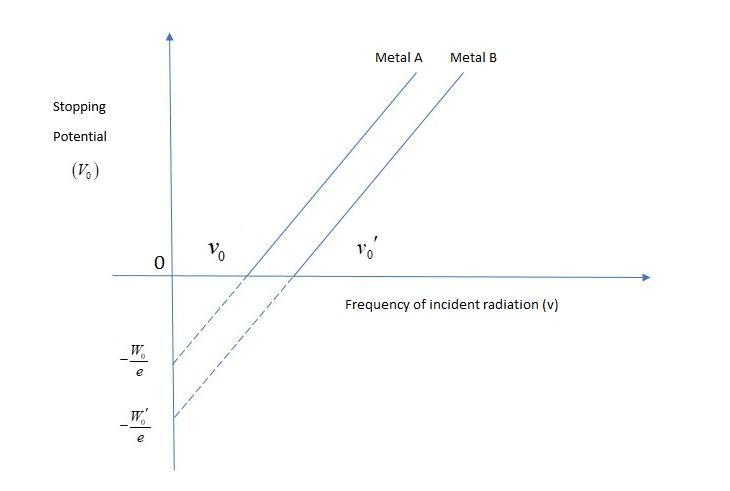
The graph shows variation of stopping potential \[{V_0}\] versus frequency of incident radiation for two photosensitive metals A and B. Which of the two metals has higher threshold frequency and why?


Answer
516.1k+ views
- Hint: Here we will proceed by defining the term threshold frequency and then we will be discussing which metal has high threshold frequency by using the given graph and explaining the exact reasons.
Complete step-by-step solution -
Threshold frequency: The threshold frequency is defined as the minimum frequency of incident radiation below which the photoelectric emission is not possible completely, irrespective of the incident radiation i.e., this frequency is just able to eject electrons without giving them additional energy.
Also stopping potential is the potential necessary to stop any electron from reaching the outside.
As the frequency increases stopping potential also increases. At zero stopping potential the frequency of incident radiation is more to metal A. Both the metals have the same stopping potential at different frequencies and this frequency is more than metal A. So, metal A has a higher threshold frequency.
Thus, metal A has high threshold frequency.
Note: Stopping potential is defined as the potential required to stop ejection of electrons from a metal surface to stop ejection of electrons from a metal surface when an incident beam of energy greater than the work potential of metal is directed on it.
Complete step-by-step solution -
Threshold frequency: The threshold frequency is defined as the minimum frequency of incident radiation below which the photoelectric emission is not possible completely, irrespective of the incident radiation i.e., this frequency is just able to eject electrons without giving them additional energy.
Also stopping potential is the potential necessary to stop any electron from reaching the outside.
As the frequency increases stopping potential also increases. At zero stopping potential the frequency of incident radiation is more to metal A. Both the metals have the same stopping potential at different frequencies and this frequency is more than metal A. So, metal A has a higher threshold frequency.
Thus, metal A has high threshold frequency.
Note: Stopping potential is defined as the potential required to stop ejection of electrons from a metal surface to stop ejection of electrons from a metal surface when an incident beam of energy greater than the work potential of metal is directed on it.
Recently Updated Pages
A man running at a speed 5 ms is viewed in the side class 12 physics CBSE

The number of solutions in x in 02pi for which sqrt class 12 maths CBSE

State and explain Hardy Weinbergs Principle class 12 biology CBSE

Write any two methods of preparation of phenol Give class 12 chemistry CBSE

Which of the following statements is wrong a Amnion class 12 biology CBSE

Differentiate between action potential and resting class 12 biology CBSE

Trending doubts
What are the major means of transport Explain each class 12 social science CBSE

Which are the Top 10 Largest Countries of the World?

Draw a labelled sketch of the human eye class 12 physics CBSE

Explain sex determination in humans with line diag class 12 biology CBSE

Explain sex determination in humans with the help of class 12 biology CBSE

Differentiate between homogeneous and heterogeneous class 12 chemistry CBSE




